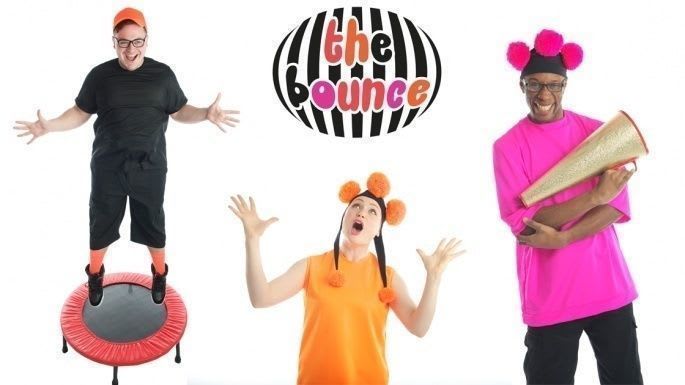The Bounce, like many of Oily Cart’s performances created for the differently-abled is not a piece of storytelling but a cleverly constructed piece of experiential theatre that explores sensation and is very interactive.
It is designed for young people from 3 to 19 who are defined as having Profound and Multiple Learning Disabilities or who are on the Autism Spectrum. I saw the version for those with autism.
Its setting (designed by Claire de Loon and lit by Jack Knowles) consists of a couple of trampolines and some manoeuvrable circular discs of fabric that can be used as projection screens.
It involves some highly technical equipment but it creates a magical, child-friendly atmosphere. It provides a central podium for a musician and a cosy corner for non-participating carers with floor seats from which they can watch from a short distance.
The Bounce participants meet some of the key performers before they enter the theatrical space. This contact both helps to make the child feel safe and comfortable with these new acquaintances in their striped circus-like attire and bobbled headgear and gives the performers an important chance to assess the child and gain some concept of what disabilities or special needs are present.
This is particularly important at public performances such as the one I attended. On visits to special needs schools, much information about participants can be gathered beforehand but there will still be a session in which to get familiar with each other.
Participants experience The Bounce in pairs. Each pair, indeed each child, will have different abilities and different responses and what happens will be varied to match what seems right for them.
I shared The Bounce with three different pairs as an observer. The first two, with whom I waited during their pre-show familiarisation, were chair-bound with little mobility, at the extreme end of the autistic spectrum; the second even less mobile, but the third were ambulant and able to make a more obviously physical response.
The first two pairs were wheeled into the theatre by their parents or carers with the performers continually engaging with them as they were slowly and gently transferred to a hoist and moved across onto a trampoline, their descent aided by a blanket stretched beneath them which then became a warm wrap to sink into.
All this, of course, is to music: the plucked stings of a kavun, a Syrian instrument of the same group as the santouri and zither, beautifully played by Maya Youseff, and singing by the whole company. It’s lovely relaxing music with pleasant pulsating rhythms to which a sonorous gong and the ting of finger cymbals later add punctuation.
The accompanying carer or parent, or both parents or, with one child, mother and fully-able sister, can join them on the trampoline, to increase confidence and provide a body to nestle to if physical support is needed.
Once settled, a gentle bouncing can begin. Degree is carefully matched to the child’s liking. When that sequence is ended, eyes are directed to the centre disc on which the shadow of a bucket appears and from behind it appear two pink buckets to be carried forward to the trampolines. They contain a variety of balls: small and smaller black ones, a big orange one with a spiked surface and a range of glitter balls.
Now, the circular screens on either side are lowered to the horizontal over each child’s head and just in touch of outstretched arms if they can use them. The balls, placed in succession on the disc’s upper surface, cast dark shadows beneath and, as the disk is tilted, run across it.
The more handicapped could only watch this or perhaps reach out to touch the moving shadows, but the last pair were able to share in the game of putting some of the balls into position and some children will be able to bounce upon the trampoline with minimal assistance.
When that has been enjoyed, the screens are raised a little and a video camera presents first one child then the other to see themselves projected. They then rise to their original position to show pre-recorded images of the facilitators mouthing and waving goodbye as the live people prepare the child for departure (using the hoists if necessary) and say goodbye.
That is basically what happens. More mobile children may stand and use the trampoline in a vertical position as well. Instead of watching the screen images, some will focus on a centrally placed but free-ranging performer who will directly play to them, often using sounds that are only part verbal.
There are many details that vary to match each child as well as the added sensations of touch and smell: the facilitators’ hands are scented with lemon or orange. The performers are attuned to discover the best ways to stimulate participants and enhance their experience, especially veteran Griff Fender who sets the standard for his younger colleagues.
This, you may complain, is not a review but a description and an inadequate one at that, but Oily Cart’s work goes beyond criticism because one can see that it is effective. Its simplicity is very moving. Each time I see their work I am amazed that, even as mere observer I find myself captivated. How much more must be the experience of the children?
In this case I felt enwrapped by a warm security and could have listened to the mesmerising sound of the kavun and mingling voices for much longer than the 70 or 80 minutes I was there. In the 20+ minutes, each child gets a concentration of attention and multi-sensory experience that is exceptional.
It is expensive and takes a lot of people a great deal of caring thought and imagination to provide it, but the results are so worthwhile.
